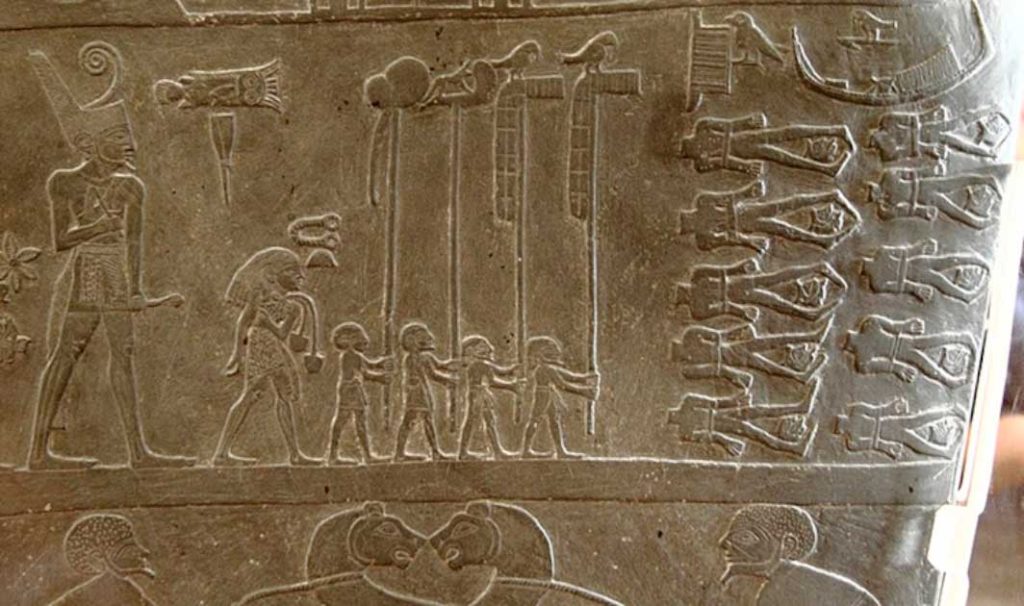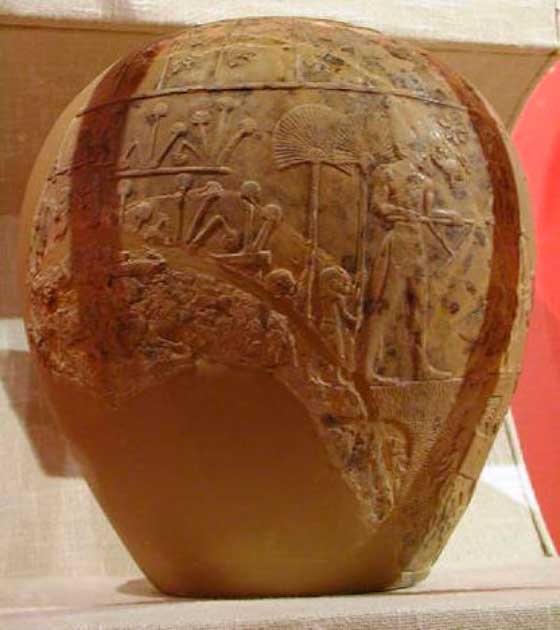In 1897 in Egypt, the explorers and archaeologists James Quibell and Frederick Green were working on an excavation in the grand Temple of Horus in the ancient Egyptian capital of Nekhen. What they found there would ignite a scholarly debate which continues to this day.
The pair were excavating some of the oldest Egyptian treasures ever found, clues to an Egypt impossibly far into the past. Before even the Old kingdom of Egypt, before the dynastic period altogether, these artifacts came from the proto-Egyptian kings who ruled five millennia ago.
Great mace heads were found, one attributed to the ancient pharaoh known as “Scorpion” who ruled around 3,000 BC. But it was the discovery of an unassuming stone block some 60 cm (24 inches) long that caused the most furor. This was the Narmer Palette, and we are still unsure what it depicts.
It is regarded as a prime example of the astonishing craftsmanship of the ancient Egyptians. Roughly triangular and covered in markings, in itself it is nothing new: cosmetic palettes are known throughout Egyptian history. However, the mystery lies in what this palette is trying to show us.
Many believe that the Narmer Palette is the very first historical document that came into existence in the world. If the carvings are true, this might be among the very first recorded history we have.
The Narmer Palette
The Narmer Palette is one of the most important and precious Egyptian ceremonial engravings that was discovered in the latter part of the 19th century. The palette is covered with ceremonial carvings along with hieroglyphic writings.

The palette is regarded to be a symbol of precise craftsmanship and unsurpassed workmanship. The carvings have been done at an intricate and elaborate level which magnifies its charm and beauty. The Narmer Palette is also incredibly ancient: dating back to the 31st century BC, it has succeeded in lasting almost five millennia without suffering from any kind of damage or wear and tear.
- The Lost City of Thinis: Where is the First Capital of Ancient Egypt?
- The Ogdoad: When Amun Ruled the Gods of Egypt
The inscriptions made on the Narmer Palette represent Narmer, a first dynasty king emerging victorious against his enemies by defeating them. The First Dynasty Egyptians believed Narmer to be the founder of that Dynasty, and by association the kingdom of Egypt. Before all that came after, there was Narmer.
His strength and success as a king and leader have been captured in the palette. A key inscription demonstrated King Narmer dressed as an Upper (southern desert) Egyptian king and raising his weapon to strike a kneeling prisoner. On the other side, Narmer wears the crown of a king of Lower (northern delta) Egypt, showing that he was ruler of the entire Nile.
The First Conquest in History?
The messages that have been carved into the Narmer Palette have been interpreted in different ways. However, most people believe that the carvings serve as a historical document, depicting King Narmer succeeding in defeating his enemies and unifying Upper and Lower Egypt into a single kingdom.
If this is the case we have a document which depicts the creation of Ancient Egypt, created at the time of Narmer’s conquest. This is therefore a depiction of a king who would create an empire which would last for millennia.
The symbolism of the Narmer Palette is complex however, and diverse images have been used to provide a precise description of the past. The images depict the absolute power and robust military of King Narmer. It is seen as a confirmation that Narmer was the real founder who helped to shape Egypt as a nation.
The divine authority of Narmer is also shown in the Narmer Palette. He has been placed in the central position of the image which captures his important role in the historical context. It shows his authoritative position as well as his success as a king.
The palette commemorates the king’s victory over ten of his enemies in Egypt. Even though there may be some kind of disagreement in terms of the precise nature of the events, the carvings are believed to show Narmer as the triumphant king.
Real or Mythology?
Aside from anything else, the military symbolism of the artifact is clear. Diverse kinds of imagery capture how Narmer as a vicious and courageous king who fought bravely against his enemies and opponents. One of the central images that have been carved in the palette depicts the conquest made by Narmer that shaped the history of Egypt.
- Herodotus and the Lost Labyrinth of Egypt: Found at Last?
- The Epic of Gilgamesh: Mankind’s First Story?
Prior to the Narmer Palette, there existed no documentation or record-keeping of vital events that shaped mankind, such as conquests and wars. The artwork gives a glimpse into what conquest looked like in historic times, and shows us that even millennia ago there were armies, and kings, and great battles between civilizations.

The artwork has given in-depth detail into the methods that King Narmer used to defeat his enemies. The conquest that has been recorded is of paramount significance not just for Egypt but for the entire globe. It captures the efforts of the king against his rivals to transform Upper and Lower Egypt into a single nation. The series of events that have been represented in the form of carvings show how conquest helped Egypt to come into being as a single kingdom.
But herein lies the problem: the Narmer Palette is essentially an origin story for Egypt, and such stories when they appear in other civilizations are almost invariably mythological. Could this too be a myth and nothing more, a story to unite and anchor the people of Egypt together?
Several things suggest not. The depiction seems unusually grounded for a myth, and although mythological creatures (notably a leopard/snake cross) appear on the Palette these are not uncommon as ornamentation in other carvings which are known to depict real events. Further, the palette emphasizes Narmer himself rather than a god, and was created at the time of his conquests, making it more likely a record of current events than a myth of times long past.
This would mean that, in this palette, we have a depiction of the first man to unite Egypt. The Narmer palette set the tone for thousands of years to come.
Top Image: Narmer on both sides of the Narmer Palette. The two different crowns show he was king of both Upper and Lower Egypt. Source: Cairo / Public Domain.
By Bipin Dimri